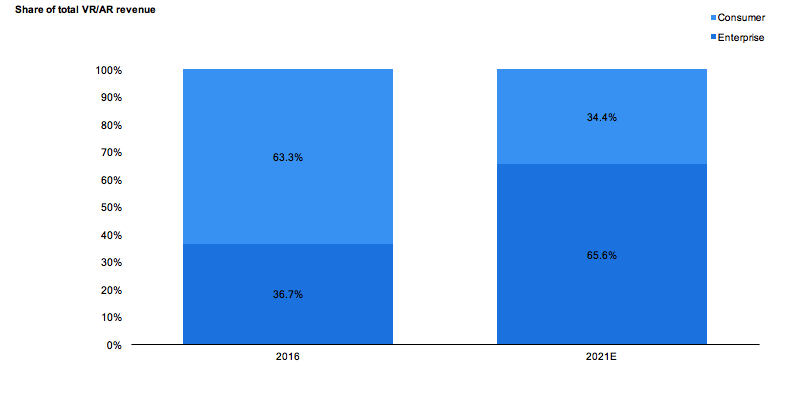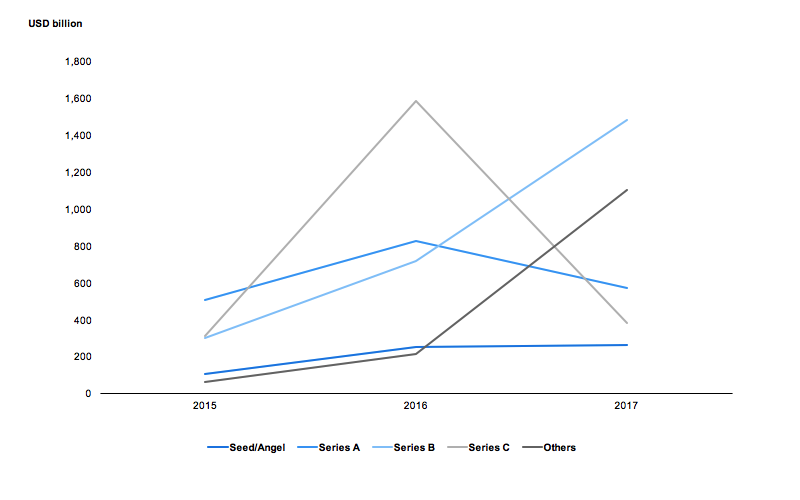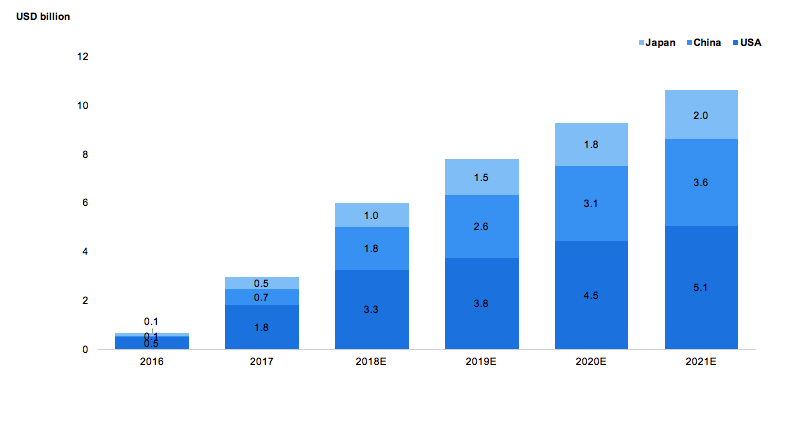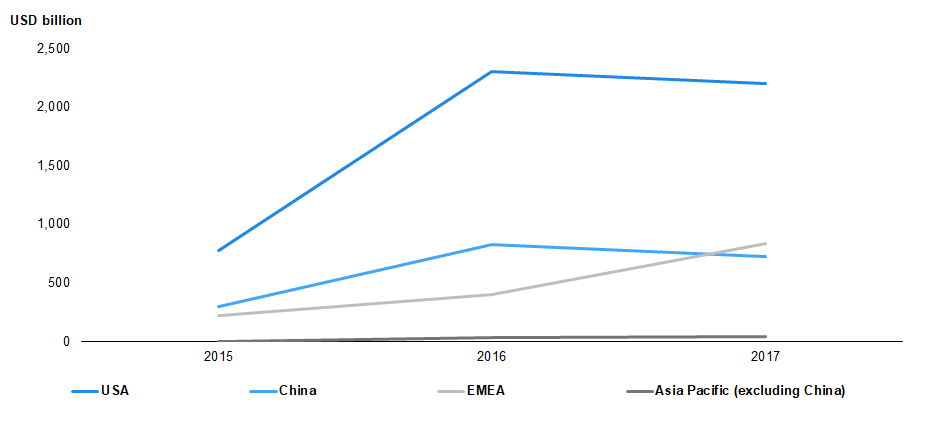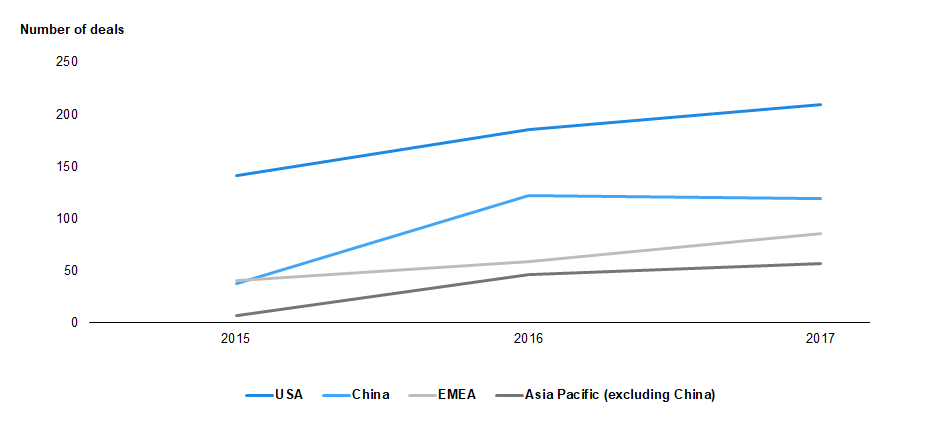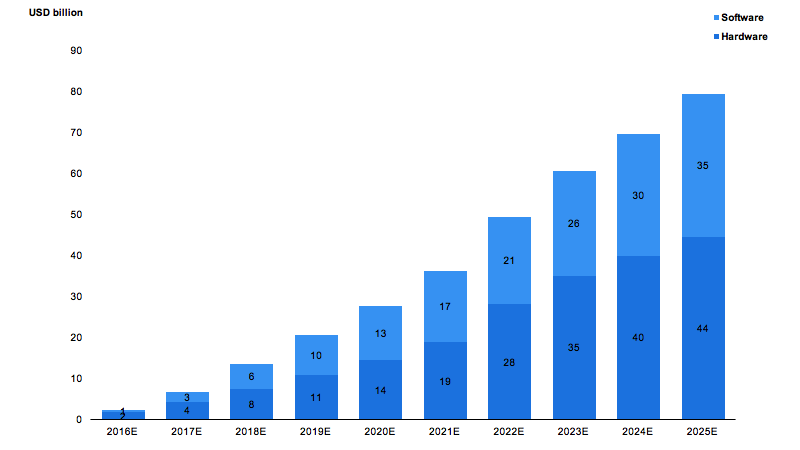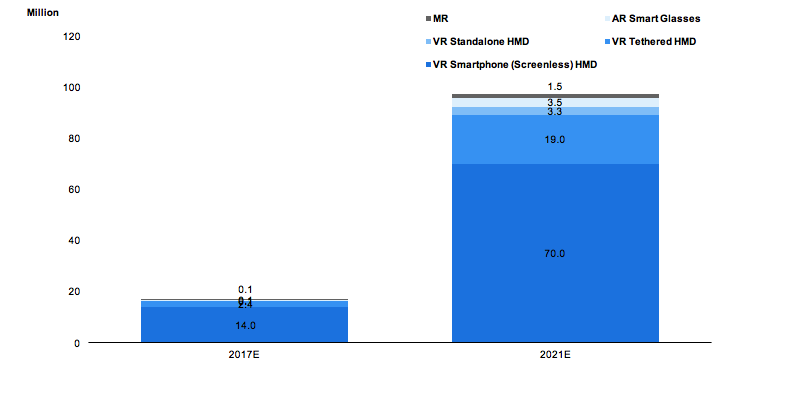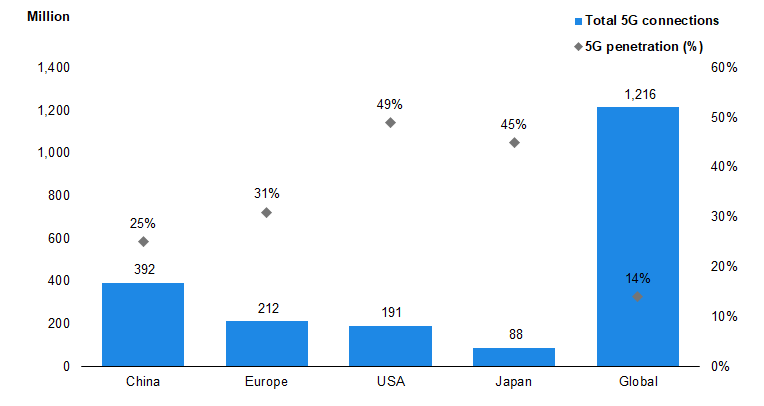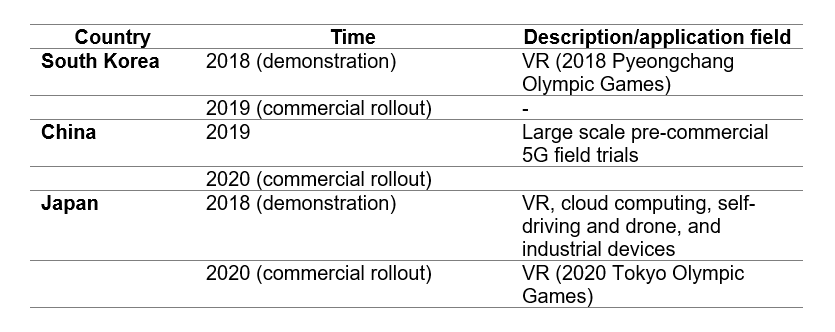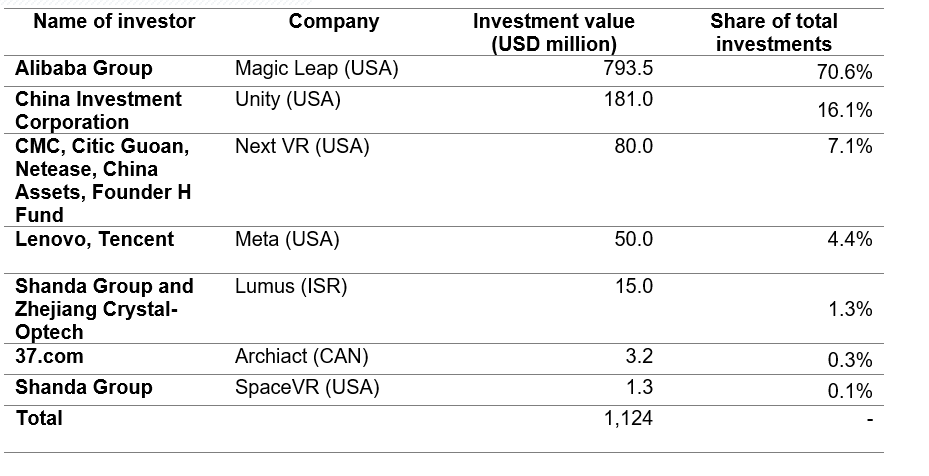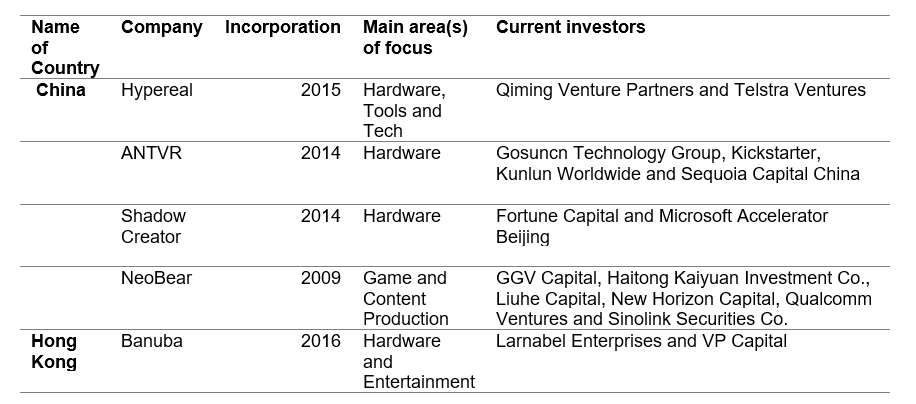Reality Technology: China Leads Asia Pacific into Frontiers of Virtually Enhanced Experience
|
Digital technology is evolving rapidly, allowing businesses to continually explore and reinvent their organisations. While many technologies compete at the forefront, reality technology in the form of augmented reality (AR), mixed reality (MR), and virtual reality (VR) allows us to enhance the experience of our environments by letting us interact virtually with people and places to which we may not otherwise have access. |
|
The global VR/AR market is valued at USD 4.2 billion (0.1% of IT spend) in 2017, with VR at the vanguard. The VR market is relatively more mature than the AR market: the required software tools and hardware platforms to create immersive VR experiences are already available.Today, despite being at a relatively nascent stage, the reality technology industry has gained global attention from investors due to its considerable potential. The global VR/AR market is projected to increase at an impressive CAGR of 70.5% over 2017–22E to approximately USD 61 billion in 2022E, with AR expected to overtake VR. This should be largely due to increased investments in AR owing to the advancement and higher applicability of AR with a larger focus from enterprises. |
|
While the USA should contribute significantly to this growth, the Asia-Pacific region is expected to grow the fastest. However, while China, the Asia-Pacific region’s largest VR/AR market, ranked as the second-largest global funding source (around 19% of global funding in 2017), it trailed the USA (58% of global funding). This was primarily due to the absence of large deals during the year, itself partly attributable to quality concerns surrounding technology in China. However, Chinese confidence seems to have recovered, with many long-term investments made over 2018Q1–Q3. Increased confidence could signal improvements in quality, which could also be attributed to increasing Asian investments in high-tech VR/AR companies outside of the region. Furthermore, China and other Asian players (e.g. Japan) lead in terms of affordability and high-tech developments in network infrastructure, which is likely to support growth. Hence, while at present the Asian market lags global peers such as the USA, it is likely to surpass them. This revolution should be led by a few emerging companies in the Asia-Pacific region, which could largely be based in emerging sectors such as manufacturing and healthcare. However, they might face challenges in the form of intellectual property concerns, consumer privacy, and data security concerns. |
|
Reality Technologies at a Glance |
|
Technology has advanced at a rapid pace, making possible today what had seemed impossible years ago. Virtual reality (VR), augmented reality (AR), and mixed reality (MR) are some of these advanced technological innovations that were science fiction a few years ago. According to research firm Coresight Research, VR, AR, and MR together form part of reality technology, a term used to describe technology that stimulates or expands the users’ current environment. |
|
|
|
|
|
According to various industry sources, the global VR/AR landscape can be broken down into three main categories, namely: 1) infrastructure; 2) tools and platforms; and 3) content. The development and optimisation of all three segments creates value for the end-user. |
|
Infrastructure (also known as hardware) refers to the equipment needed in order to use the technology. This can include head-mounted display (HMD) devices, AR glasses, cameras, sensors, and other peripherals required for interacting with the virtual world. In VR systems, we commonly see the following used: |
|
1. Smartphone HMDs (systems that house smartphones) – examples include Google Cardboard and Samsung Gear VR; 2. Tethered HMDs (systems that connect to a PC or processing platform via wires and cables) – Examples include Oculus Rift, HTC Vive, and PlayStation VR; 3. Standalone HMDs (systems with independent computing power that can deliver VR/AR experiences without any external hardware) – examples include Microsoft HoloLens, Google Glass, and Magic Leap. |
|
’Tools and platforms’ (also known as ‘tools and tech’) include content-creation tools, middleware, 3D conversion, and user interface plugins, among others. They also include technologies that are applicable across platforms (e.g. computer vision, streaming and compression), mostly delivered in software. |
|
Content includes actual content made for the immersion of a user in a virtual experience. They are often categorised into 1) games and entertainment and 2) enterprise/verticals. In terms of players, it can be observed that most global technology giants such as Google and Apple have already involved themselves across the value chain, despite the industry being relatively new. |
|
Global Tech Giants Play Leading Role Across Value Chain |
|
|
|
Source: Compiled by UZABASE based on various sources |
|
VR Currently Dominates Global Market on Revenue, Driven by High Investments; AR to Gain Lead via Advancements in Technology and Applicability |
|
In recent years, VR/AR has evolved and emerged to become a standalone industry. As per ARtillry, a publication and intelligence firm for VR/AR, the global VR/AR market was valued at USD 4.2 billion in 2017 (Note (1)), accounting for a mere 0.1% of global IT spend, as per Statista based on Gartner. VR dominated the global market revenue, accounting for an approximate share of 56% of global revenue in 2016 (latest data available for breakdown), while AR accounted for the rest. This was because of the VR market’s higher relative maturity compared with AR’s: the required software tools and hardware platforms to create immersive VR experiences are already available. (Note (1) Any use of different values for VR/AR revenue in this report is footnoted on the respective page.) |
|
However, also as per ARtillry, global VR/AR revenue is projected to increase at an impressive CAGR of 70.5% over 2017–22E to approximately USD 61 billion in 2022E, with AR expected to overtake VR to account for an approximate share of 80% of global market revenue by 2021E. This should be largely due to increased investments in AR, owing to the advancement and higher applicability of AR, with a larger focus from enterprises. In turn, as per ARtillry, enterprise VR/AR is expected to dominate global VR/AR revenue, with a share of 65.6% by 2021E. |
|
Today, AR has been identified as a tool that could have significant use in real-world scenarios. For instance, AR is already used to deliver real-time information to support diagnosis, surgery, and treatment plans. This was seen at the introduction of AccuVein — a handheld device that can scan the vein network of a patient; the technology reduces escalations in approximately 45% of interventions. Furthermore, using AR diagnostic tools, surgeons can plan procedures before making the first cut, make models of tumours, and model disease conditions for further study. AR can also be used for home remodelling. For example, the Ikea Place App, which was built on Apple’s ARKit technology, helps customers scan their rooms and virtually place Ikea objects in the rooms to design a new environment with new products; the app helps customers make informed choices before buying new furniture. As AR matures, its higher applicability should translate into increasingly useful innovations. |
|
Global VR/AR Revenue to Grow at a CAGR of 70.5% over 2017–22E |
|
|
|
Source: ARtillry Intelligence, “XR Global Revenue Forecast, 2017–22” |
|
AR to Dominate Global VR/AR Market Revenue by 2021E |
|
|
|
Source: ARtillry Intelligence Briefing, “XR Global Revenue Forecast, 2016–21” |
|
Note 1: Latest data available for breakdown is 2016 |
|
Note 2: Graph used to look at VR/AR trends, despite an update being made in 2017 |
|
Enterprise Revenue to Dominate Global VR/AR Market, 2021E |
|
|
|
Source: ARtillry Intelligence Briefing, “XR Global Revenue Forecast, 2016–21” |
|
Note 1: Latest data available for breakdown is 2016 |
|
Note 2: Graph used to look at VR/AR trends, despite an update being made in 2017 |
|
As per Virtual Reality Venture Capital Alliance (VRVCA; a membership of 49 of the top VR investors globally), global VR/AR funding grew at a strong CAGR of 88.7% over 2013–17 to USD 3.8 billion in 2017, with the value increasing nearly 3x over 2015–17. Furthermore, the number of global deals rose 11x over the same period to 475 deals in 2017, with the deal count doubling over 2015–17. |
|
Growth in funding over 2015–17 (latest period available for breakdown) was driven largely by Series B funding (cumulative contribution to growth: 47.3%), although it accounted for only 6.9% of global deals over the period. This was despite a focus among many investors on early-stage deals (seed/angel and Series A funding accounted for 85.1% of total deals). Furthermore, others (beyond Series C) contributed 44.2% of total growth in funding over the period, despite a minor deal share (6.2%) owing to larger value deals such as Magic Leap and Niantic. |
|
Global VR/AR Funding Trended Upwards, Dominated Largely by VR |
|
|
|
Source: VRVCA, “VR/AR Global Investment Report and Outlook 2018″ |
|
Series B Funding Increased Steadily; Series C Saw Steepest Decline in 2017 |
|
|
|
Source: VRVCA, “VR/AR Global Investment Report and Outlook 2018″ |
|
Note 1: Angel – An angel round is typically a small round designed to get a new company off the ground. Investors in an angel round include individual angel investors, angel investor groups, friends, and family. |
|
Note 2: Seed – Seed rounds are among the first rounds of funding a company will receive, generally while the company is young and working to gain traction. A seed round typically comes after an angel round (if applicable) and before a company’s Series A round. |
|
Note 3: Series A and Series B rounds are funding rounds for earlier stage companies. |
|
Note 4: Series C rounds and onwards are for later stage and more established companies. |
|
Seed/Angel Deals Continue to Dominate Deal Count, with Steady Growth |
|
|
|
Source: VRVCA, “VR/AR Global Investment Report and Outlook 2018″ |
|
USA Leads Global Market Revenue, Supported by Historical Investments; Asia Pacific Shows Potential Despite Lower Investments |
|
In terms of a geographic split, as per the International Data Corporation (IDC), the USA was estimated to have become the largest global revenue source in 2017E (Note (2)), accounting for a share of 28.1%, followed by the Asia-Pacific region (26.3%). The USA’s dominance in the global VR/AR market is supported by the country’s leading global deal share (approximately 44% of global deals in 2017). Historical investments have led to many start-ups and technological developments in the USA (the latter reflected in the number of patent applications, strongly supported by intellectual property laws), thereby making the country one of the pioneers of VR/AR technology. (Note (2) Different source for revenue used as ARtillry did not have geographical breakdown.) |
|
According to technology research firm Venture Scanner, the USA ranked as the top country for VR firms, recording a total number of 375 firms as of July 2017, accounting for 52.7% of global VR firms tracked. Furthermore, the USA filed a total of 10,295 patent applications for VR over 1994–2017, accounting for 27.4% of global VR patents. This was followed closely by China (21.7%). |
|
USA Leads Global VR/AR Market by Revenue, Followed Closely by Asia Pacific, 2017E |
|
|
|
Source: IDC |
|
USA Leads Global VR Firms, July 2017 |
|
|
|
Source: Venture Scanner |
|
USA Leads Global VR Patents, Followed Closely by China, 1994–2017 |
|
|
|
Source: Scientific Research Publishing, “Proposals to Promote the Development of Virtual Reality in China — Based on Patent Econometric Analysis” |
|
In order to gauge who is likely to lead growth in the global VR/AR market, we look at revenue from VR by country (Note (3)). As per Statista based on PwC, the USA is expected to see VR revenue grow at a CAGR 58.8% over 2016–21E to USD 5.1 billion in 2021E, accounting for 45.7% of the revenue contribution by the top three countries for VR patents (the USA, China, and Japan). However, China is expected to grow faster (71x over the period; CAGR above 100%), as is Japan (CAGR of 82.1%). This faster potential growth in Asian countries can be attributed to investments in VR (similar to those in AR, in our view) being realised later towards the end of the forecast period. (Note (3) Information for AR by region is unavailable.) |
|
USA to Continue to Lead Global VR Revenue Among Top Three Patent Countries; Asia to Grow the Fastest |
|
|
|
Source: Statista based on PwC |
|
Note: Figures for 2016 include the USA (USD 0.5 billion) and China and Japan (USD 0.1 billion each) respectively |
|
The Asia-Pacific region contributed 18.4% of funding growth in total over the period, led by China. Despite accounting for approximately 25% of global deals in 2017, China ranked as the second-largest source of VR/AR funding, contributing approximately 19% of total global funding in 2017 (versus 23% in 2016). China trailed the USA, which accounted for approximately 44% of global deals in 2017, with a total funding share of approximately 58% for the same year. In addition to lower deals, China also lacked large deal values; this can be attributed partly to the lower maturity of the country’s technology compared with global peers’. However, as per Digi Capital, Chinese confidence seems to have recovered, with many long-term investments made over 2018Q1–Q3. Increased confidence could signal improvements being made in quality, which could also be attributed to increasing Asian investments in high-tech VR/AR companies outside of the region. Furthermore, China is recognised as a key region for VR/AR, as per the VRVCA, owing to its unique investment opportunities. For instance, the country hosts nearly 5,000 VR arcades, cinemas, and experience centres — nearly 10x the USA’s. Hence, as China’s technology matures, it is likely to be a strong competitor for the USA as returns from current investments materialise over time. |
|
USA and China See Decline in Funding in 2017; EMEA Registers Steady Growth |
|
|
|
Source: VRVCA, “VR/AR Global Investment Report and Outlook 2018″ |
|
Note : EMEA stands for Europe, the Middle East, and Africa |
|
China’s Deal Count Declined in 2017; USA Saw Steady Growth |
|
|
|
Source: VRVCA, “VR/AR Global Investment Report and Outlook 2018″ |
|
Note: EMEA stands for Europe, the Middle East, and Africa |
|
Lower Production Costs and Improvements in Network Infrastructure Underpin Asia-Pacific Growth |
|
Apart from large-scale investments, our analysis also identified two other key factors that have supported VR/AR development in the Asian market (the following list is not exhaustive). |
|
• China Leads in Terms of Hardware Affordability Despite Quality Concerns; Smartphone HMDs Dominate Hardware Shipments Due to High Affordability |
|
As per Goldman Sachs, hardware is expected to dominate the global VR/AR market, with revenue growing at a CAGR of 43.3% over 2016E–25E to approximately USD 44 billion (Note (4)) in 2025E. Software is expected to grow at a faster CAGR of 57.6% over the same period to approximately USD 35 billion in 2025E. Faster growth in software is likely to be due to the base expansion of installed hardware, which in turn could create increased demand for high-quality content and services. (Note (4) Revenue breakdown sourced from Goldman Sachs, as it was not available from ARtillry.) |
|
Hardware to Continue to Dominate Global VR/AR Market; Software to Grow the Fastest |
|
|
|
Source: Estimated by UZABASE based on Goldman Sachs, “Virtual & Augmented Reality” |
|
Note 1: Latest available projections were made in 2015 |
|
Note 2: Values for 2016E include hardware (USD 2 billion) and software (USD 1 billion) |
|
In terms of hardware platforms, as per market research firm CCS Insights, global VR/AR device shipments are expected to grow at a CAGR of 55.4% over 2017E–22E to 97.3 million units in 2022E, with smartphone HMDs (screenless) leading the market (contribution to growth: 69.5%; CAGR: 49.5%) over the same period. However, other devices such as tethered HMDs and standalone HMDs are expected to grow faster owing to their greater functionality. Nevertheless, today, smartphone HMDs are relatively more affordable than other types of devices. As per Morgan Stanley Research, as of September 2017, the average incremental costs of owning a wired VR device was approximately USD 1,000, which was nearly 7x the incremental cost of owning a mobile VR device. Mobile VR/AR tends to be less expensive because of its minimal requirement of hardware. However, the level of virtualisation is far lower compared with that of wired devices. |
|
Smartphone HMDs Continue to Lead VR/AR Hardware Shipments Despite Growing the Slowest |
|
|
|
Source: VR Scout based on CSS Insights, “Report: Global VR Hardware Revenue to Hit USD 3.6 Billion in 2017” |
|
|
|
As per market intelligence firm Newszoo, global smartphone users are expected to increase at a CAGR of 11.6% over 2015–20E to 3.6 billion users in 2020E (46.2% of the global population in 2020E versus 27.1% in 2015), supported largely by increasing affordability and improved data plans. Furthermore, as per Statista, the average selling price (ASP) of VR screenless viewers is expected to decline at a CARC of 11.5% over 2016–20E to approximately USD 62 in 2020E, much lower than the ASP of VR tethered devices (CARC of 9.4% to USD 411 in 2020E) and VR standalone HMDs (CARC of 9.4% to USD 357 in 2020E). This implies that despite a potential increase in the usage of standalone and tethered VR/AR devices with higher virtualisation among mid- to high-end users, low-end consumers are likely to continue to find screenless VR/AR more affordable, unless the prices of other devices register steeper declines. |
|
In fact, the prices of many VR devices have been declining owing to strong competition between manufacturers and increasing production with cheaper raw materials. However, Asian countries such as China have produced VR/AR devices at costs much lower than their global peers’. For example, BoboVR Z3, a Chinese mobile VR HMD, priced at approximately USD 18 as of 2017, was nearly 6x cheaper than Samsung Gear VR (USD 99). Similarly, VR Shinecon was priced at approximately USD 23 the same year, nearly 9x cheaper than LG 360 VR (USD 199). However, Chinese VR/AR devices are known for a lack of quality, and this puts the market at a disadvantage, unless significant effort is put into addressing the quality of devices. |
|
ASP of VR Screenless Viewers to Remain Cheaper than Other Platforms |
|
|
|
Source: Statista based on Bank of America; Merrill Lynch |
|
Note: Latest available data for actuals is 2016 |
|
• Asia Leads in Terms of Improving Network Infrastructure for VR/AR |
|
In spite of the recent adoption of VR/AR, the market faces some challenges in terms of infrastructure and connectivity. In fact, most virtual experiences require considerable bandwidth for premium content experiences; coupled with all-day device usage, this leads to unprecedented network strain, which current network infrastructure cannot fully support. The introduction of 5G and its continued development is likely to allow AR and VR to reach its full potential. As opposed to 4G networks, 5G helps reduce latency (delay), introduce more capacity, and provide for a more uniform experience. |
|
Based on the International Telecommunication Union’s (ITU’s) standards for International Mobile Telecommunications (IMT), 5G aims to deliver speeds of around 20 gigabytes per second (Gbps), approximately 20x faster than 4G (0.01–1.00 Gbps) and capable of supporting advanced VR/AR applications. Furthermore, the ITU also notes that 5G latency could be as low as 1–4 milliseconds (10–98 for 4G). As per the Global System for Mobile Communications (GSMA; a trade body that represents mobile operators’ interests), global 5G connections are expected to reach 1.2 billion by 2025E and to account for approximately 14% of total mobile connections. China is projected to lead global 5G connections with a 32.2% share of global connections, followed by the USA (15.7%) and Japan (7.2%). However, the initial deployment of connections is expected to take off in South Korea in 2019, making it the first country to do so. |
|
China to Lead Global 5G Connections; Japan and USA to Register the Highest Penetration Rates, 2025E |
|
|
|
Source: GSMA, “5G Era: The Opportunities and Challenges” |
|
Note: 5G penetration represents total 5G mobile connections as a percentage of total mobile connections |
|
South Korea to Pioneer Commercial Deployment of 5G in Asia Pacific |
|
|
|
Source: GSMA, “Mobile Economy: Asia Pacific 2017” and China Academy of Information and Communications Technology, “Virtual Reality/Augmented Reality White Paper” |
|
Asian Companies Focus on Strategic Investments to Improve Technological Know-How; Funding Moves into Enterprise Applications |
|
As of today, VR/AR is one of the most widely discussed concepts in today’s global technology circles. In fact, VR/AR shows potential to make a significant change in the way we work, experience entertainment, or even make purchases and participate in social activities. |
|
While at present Asia lags behind North America in terms of VR/AR adoption and market revenue, our analysis concludes that the Asian market shows considerable growth potential for VR/AR adoption, with countries such as China and Japan likely to take the lead. |
|
In terms of areas of global investment, the largest deals seen over 2015–17 were in enterprise services/vertical applications (36.5% of global deals over the period), followed by tools and tech (21.3%), according to VRVCA. However, despite accounting for 14.2% of global deals across 2015–17, hardware led global funding, accounting for a share of 41.2%, followed by tools and tech (27.7%). In contrast, gaming and entertainment accounted for 21.0% of global deals during the same period, while accounting for only 17.9% of global funding. |
|
As per the same source, higher funding in categories other than gaming and entertainment is often due to investors’ increased focus on tools and technologies that can be applied across various content and platforms and enterprise services that have faster product-market-fit validation and monetisation cycles. This implies growing interest in areas outside of the consumer market. In turn, as per ARtillry, Enterprise VR/AR is expected to dominate global VR/AR revenue, with a share of 65.6% by 2021E, implying that investments in hardware, tools, and technology are likely to absorbed more by the enterprise market. |
|
Hardware Dominates Global VR/AR Funding Despite Accounting for Minor Global Deal Share, 2015–17 |
|
|
|
Source: VRVCA, “VR/AR Global Investment Report and Outlook 2018″ |
|
This in turn could imply that Asian companies, which are often known for quality concerns, could potentially see increasing investment deals in other verticals apart from gaming, if they focus on quality in terms of content and devices. In China, for example, investors are keen to invest in overseas VR companies that have advanced VR technologies that could help Chinese enterprises improve their technological know-how and thereby explore expansion opportunities abroad. |
|
Leading Chinese Overseas VR/AR Investment Projects, 2016 |
|
|
|
Source: Digi-Capital |
|
However, the Asian market is relatively fragmented, with various VR/AR manufacturers offering too many different brands in the market, each with a different proposition. While this may bode well for the industry as a whole, as different VR/AR devices and content can be applied to different verticals, it would also make it difficult for any VR/AR technologies to be applicable across the entire industry as a whole. |
|
Popular VR/AR Startups in Asia |
|
|
|
Source: Compiled by UZABASE based on various sources |
|
However, new VR/AR companies are likely to face risks in terms of 1) consumer privacy and data security; 2) intellectual property infringement; 3) compliance with platform requirements in publishing content; and 4) product liability and health issues. |









